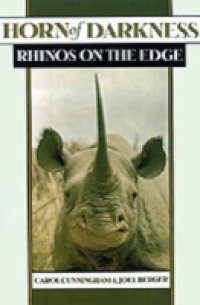The black rhino is nature's tank, feared by all animals. Even lions will break off a hunt to detour around one. And yet the black rhino is on the edge of extinction, its numbers dwindling from 100,000 at the turn of the century, to less than 2,500 today. The reason is that in places like Yemen, China, Korea, Taiwan, and Thailand, the rhino's horn is more valuable than gold, so valuable that people will risk their lives to harvest it. To deter rhino poachers, African governments have spent millions--on helicopters, paramilitary operations, fences and guard dogs, even relocation to protected areas. Finally, Namibia decided to dehorn its rhino population, in a last ditch effort to stop the slaughter. In 1991, Carol Cunningham and Joel Berger, and their eighteen-month-old daughter Sonja, went to Namibia to weigh the effects of dehorning on rhinos. In Horn of Darkness, they tell the story of three years in the Namib Desert, studying Africa's last sizable population of free-roaming black rhinos. This is the closest most readers will come to experiencing life in the remaining wilds of Africa. Cunningham and Berger, writing alternate chapters, capture what it is like to leave the comforts of civilization, to camp for months at a time in a land filled with deadly predators, to study an animal that is reclusive, unpredictable, and highly dangerous. The authors describe staking out water holes in the dead of the night, creeping to within twenty-seven meters of rhinos to photograph them, all the while keeping a lookout for hyenas, elephants, and lions. They recount many heart-pounding escapes--one rhino forces Carol Cunningham up a tree, an unseen lion in hot pursuit of hyenas races right past a frozen Joel Berger--and capture the adrenaline rush of inching closer to a rhino that might flee--or charge--at any moment. They also give readers a clear sense of the careful, patient work involved in studying animals, the frustration of long days without finding rhinos or seeing other people, coping with heat and thirst (the Namib desert is one of the driest on Earth), with dirt and insects, driving hundreds of kilometers in a Land Rover packed to capacity, slowing amassing records on one hundred individual rhinos over the course of several years. And perhaps most important, the authors reveal that the data they collected suggests that the dehorning project might backfire--that in the four years after dehorning began, calf survival was down (the evidence suggests that hyenas might be preying on calves and the hornless mothers couldn't defend their offspring). They also describe the dark side of scientific work, from the petty jealousy of other scientists--outside researchers were often seen as ecological imperialists--to the controversy that erupted after the authors published their findings, as furious officials of the Namibian conservation program denounced their findings and through delays and other tactics effectively withheld a permit to allow the couple to continue their study. Weaving together the historical accounts of other naturalists, a vividly detailed look at life in the wild, and a behind-the-scenes glimpse of scientific work and the dark side of the conservation movement, Horn of Darkness is destined to be a classic work on the natural world.

